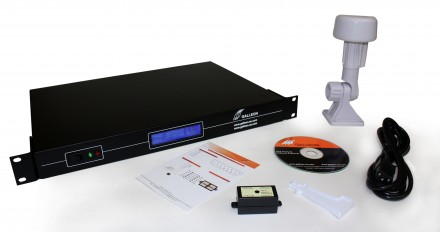What is NTP Time and How Does it Benefit Me?
To explain “What is NTP Time?” a brief introduction of how important time synchronization is, is required. Time synchronisation is essential for computer networks, especially those that conduct time sensitive transactions. Time, in the form of time stamps, is used by computers to identify when a transaction has taken place or needs to take place. Therefore, if time differs across a network all sorts of things can go wrong, from transactions not occurring to data getting lost.
Because of the importance of time for computer and technologies, a time server system is required to not only keep all devices on a network running at the same time, but also ensure that different computer networks that speak to each other are also synchronized. Of course, this isn’t easy, especially in today’s age when networks have to communicate across time zones, which is where NTP comes in.
What is NTP
Network Time Protocol (NTP) is a software algorithm that keeps computers and other technologies synchronised. NTP has been around almost as long as the internet itself, and its success is due to its effectiveness of keeping devices synchronised to within a few milliseconds of each other (thousands of a second), but it can only do this if it has a reliable form of time with which to use as a master time source.
NTP works by using a single time source, which it uses to synchronise all devices on a network to. As computer networks communicate with each other across time zones and often from the other side of the world, this master time needs to not only be ubiquitous, but also highly accurate, otherwise networks in different parts of the globe could be running slightly different times.
For their master time source, most NTP networks use Coordinated Universal Time (UTC). This is because UTC is not only the same no matter what time zone you are in, but also it is kept accurate by a constellation of atomic clocks. These clocks ensure that UTC is maintained to extreme precision, and getting a source of UTC time requires using a NTP time server.
The atomic clocks that maintain UTC are situated in national physics laboratories, and are not devices that can installed in the average server room to maintain time synchronisation. However, a source of UTC can be received by a NTP time server that either gets it from a radio signal broadcast by these physics laboratories, or from the GPS (Global Positioning System) network.

NTP works by taking this time source and using it as a basis with which to adjust all the system clocks on the devices on its network. This is done repeatedly to avoid any drift, so if a system clock is a few milliseconds from the UTC source it is altered to ensure it is maintaining the same accurate time as every other device hooked up to the NTP network.
Benefits of NTP time for a business or organisation
Maintaining accurate and synchronised time has never been so important for businesses and organisations. In today’s world, where so many transactions take place online, having a synchronised and accurate network time is crucial for businesses, especially those organisations that conduct their business over the internet or with other computer networks.
Having an NTP synchronised network means that a business network can communicate with other networks across the globe, without fear that time discrepancies will cause problems. Because NTP time is identical everywhere, timestamps never differ, so transactions that takes place even over different time zones will not cause errors. Furthermore, as more people conduct business over the internet, having a solid reliable from of time is crucial as not all users will have a system with an inaccurate time source. Having a NTP synchronised network means you have a guaranteed time source, that will provide a timestamp according to UTC time, to ensure that differences between host and peer won’t cause problems.
Accurate time is also important for security too. Hackers and malicious software, such as computer viruses, can easily take advantage of a system without accurate time, using the discrepancies in time to slip through any security measures such as firewalls or anti-virus software. However, if all devices are maintained to NTP time, it is much harder for malicious users to gain access to a system, which can prevent untold damage to both a network’s functionality and an organisation’s reputation.
What is NTP time management
Having an NTP time managed network can prevent all sorts of problems. Because timestamps are the only method with which computers can tell whether a transaction has occurred or not, if several devices on a network are running different times, errors can easily occur because the network won’t know which timestamp to trust. This could lead a network to believe a transaction has taken place when it hasn’t, transactions being repeated, or data becoming loss. This is because to store any data, a system needs a timestamp in order to store the information. However, if that timestamp differs between machines, the system may believe the data has already been stored, leading to the information becoming being discarded.
NTP time synchronization is also critical for auditing and managing a system. If the unthinkable happens and a system is infiltrated by a piece of malicious code or an unauthorised user, tracking down where and when this happened can only be done with an accurate timestamp. Furthermore, if fraud or another criminal act takes place, a system that is synchronised with an NTP time server will have an auditable trail, and because the time comes from an atomic clock source, it is irrefutable, and can therefore be used in any potential legal proceedings.

For systems that deal with time sensitive transactions, NTP time synchronisation is even more critical. CCTV cameras, speed traps and ATM machines couldn’t function without an NTP server. Just think of the chaos that would occur if two ATM machines had different times. People would be able to withdraw the same funds twice. The same is true for any financial transactions. The stock exchange and other financial centres rely heavily on NTP time servers because of the frequency with which prices change each second.
An inaccurate network is also highly insecure. Time discrepancies allow all sorts of malicious users and software to wreak havoc on a system, and often not having accurate time can mean putting things right can be almost impossible. Without accurate time stamps, debugging and identifying breaches can be extremely difficult, and it doesn’t take much of a discrepancy for someone or something to take advantage of this lack of security.
What Time Server Do I Need For My Business?
Time servers come in various different types, and the right NTP time server for your business may depend on several things. This will be discussed in more detail in the article: “What Time Server Do I Need for My Business?” which will be posted in two weeks time. However, in summary, choosing a time server is dependent on how many devices you need to synchronise and whether you want to receive a source of time through radio transmissions or GPS signals.
Some time servers are designed to synchronise just single machines. These are useful for devices working independently of a network and normally receive the time from a radio signal, and are able to keep the device to within a few milliseconds of UTC, ensuring it always has accurate and precise time. Other NTP time servers are designed to synchronise whole networks. In some cases, a single time server can keep hundreds and even thousands of PCs, routers and other technologies all running the same time.
NTP time servers are able to maintain time on so many devices because of the stratum system they employ. In short, NTP delegates primary machines as high-level devices, which are employed to help distribute the time to devices lower down the strata, which in turn distribute the time to devices lower down than them. This prevents a single NTP server from becoming congested with repeated requests for the time, but because all devices are linked to the same NTP time server, no matter how far down on the stratum level a machine is, it will be just as accurate as those devices higher up.
The final deciding factor as to what type of NTP server is required is whether you want a GPS time server or one that utilises radio frequencies. These radio frequencies are distributed from various national physical laboratories in Europe and the US. However, they are not available everywhere and increasingly most people choose a time server that gets its time from the GPS network.

GPS signals have the advantage of being available everywhere on the planet. However, in order for an NTP server to utilise GPS time, an antenna has to be placed somewhere that has a clear view of the sky. This is because GPS signals work by line of sight, and for some organisations, such as those on the lower floors of a high rise building, this may not be practical, which would make a radio referenced NTP server the better choice.